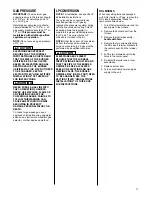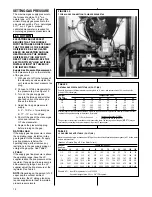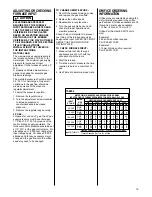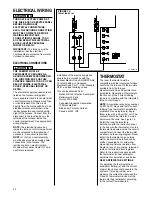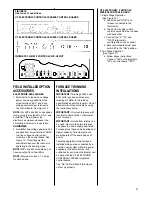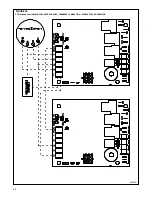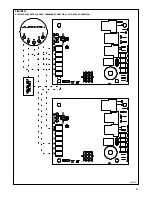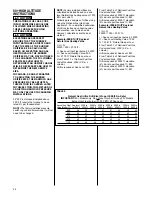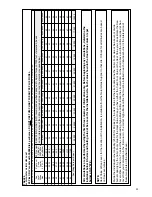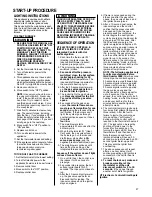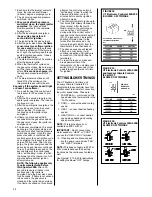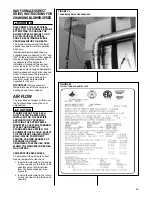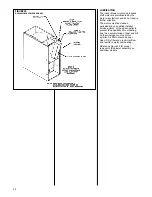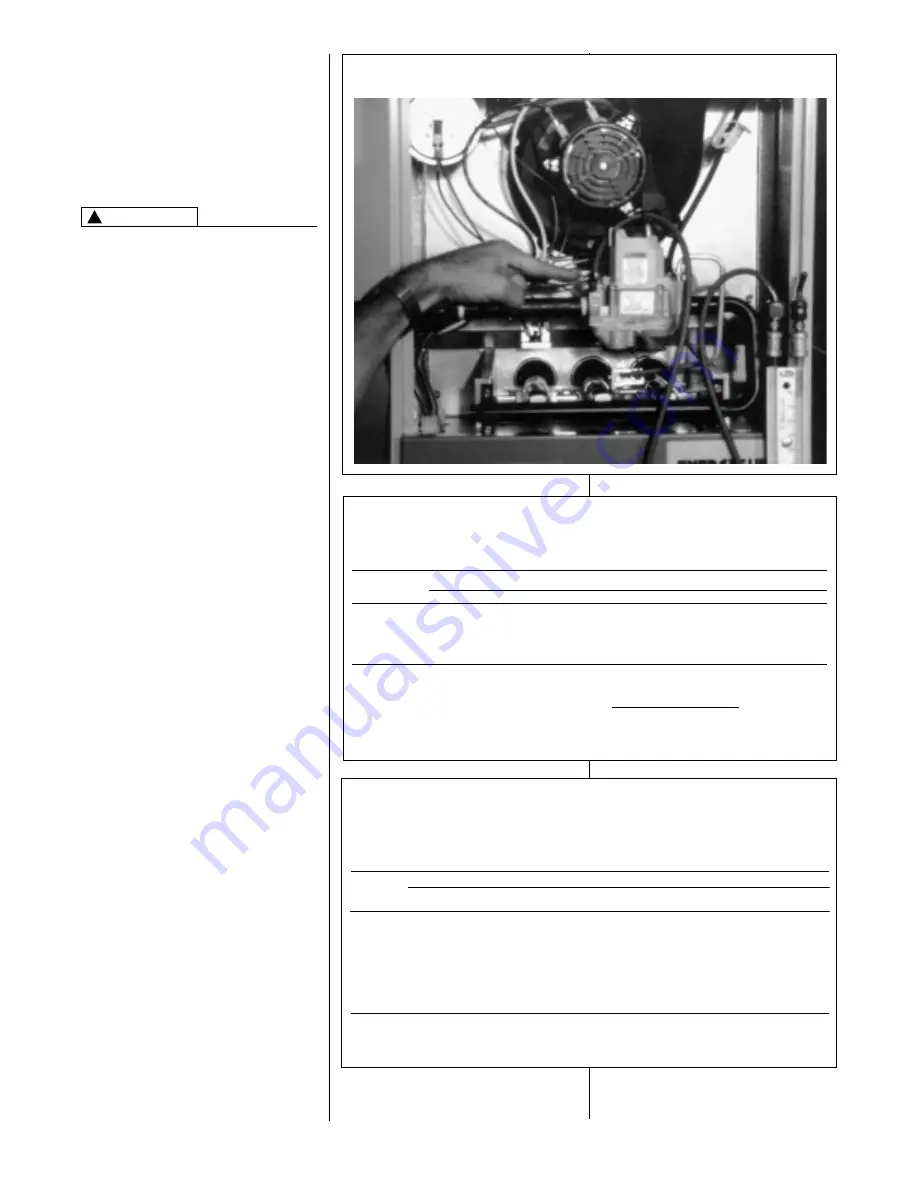
18
TABLE 3
LP GAS PIPE CAPACITY TABLE (CU. FT./HR.)
SETTING GAS PRESSURE
The maximum gas supply pressure to
the furnace should be 10.5
”
w.c.
natural gas, or 13
”
w.c. LP gas. The
minimum supply gas pressure to the
gas valve should be 5" w.c. natural gas
or 11" w.c. LP gas. A properly
calibrated manometer is required for
accurate gas pressure measurements.
ELEVATIONS ABOVE 2000 FT
REQUIRE THAT THE FURNACE
INPUT RATING BE ADJUSTED AND
THAT THE SIZE OF THE BURNER
ORIFICES BE RE-CALCULATED
BASED ON ELEVATION AND GAS
HEATING VALUE. THE BURNER
ORIFICES MAY (OR MAY NOT)
NEED TO BE CHANGED. SEE THE
SECTION TITLED “HIGH ALTITUDE
INSTALLATIONS” OF THIS BOOK
FOR INSTRUCTIONS.
Supply Gas Pressure Measurement.
A line pressure tap is on the inlet side
of the gas valve.
1. With gas shut off to the furnace at
the manual gas valve outside the
unit, remove the input pressure tap
plug.
2. Connect a U-Tube manometer to
the pressure tap. See Figure 13.
3. Turn on the gas supply and
operate the furnace and all other
gas-fired units on the same gas
line as the furnace.
4. Adjust the line gas pressure to
supply:
A. 5” - 10.5” w.c. for natural gas.
B. 11” - 13” w.c. for LP gas.
5. Shut off the gas at the manual gas
valve and remove the
U-Tube manometer.
6. Replace the pressure tap plug
before turning on the gas.
NATURAL GAS:
If the supply gas line pressure is above
the operating range, install an in-line
gas regulator to the furnace. If supply
gas line pressure is below the
operating range, either remove any
restrictions in the gas supply piping or
enlarge the gas pipe. See Table 2.
LP GAS:
If the supply gas line pressure is above
the operating range, have the LP
supplier reduce the line pressure at the
regulator. If supply gas line pressure is
below operating range, have the LP
supplier adjust the line pressure at the
regulator. See Table 3.
NOTE:
Depending on the amount of LP
vapor and the outdoor ambient
temperature, the LP storage tank may
require supplemental heat to maintain
proper pressure levels.
FIGURE 13
TYPICAL HOSE CONNECTION TO LINE PRESSURE TAP
Maximum capacity of pipe in thousands of BTU per hour of undiluted liquefied petroleum gases (at 11 inches water
column inlet pressure).
(Based on a Pressure Drop of 0.5 Inch Water Column)
Nominal
Length of Pipe, Feet
Iron Pipe
Size, Inches
10
20
30
40
50
60
70
80
90
100
125
150
1/2
275
189
152
129
114
103
96
89
83
78
69
63
3/4
567
393
315
267
237
217
196
182
173
162
146
132
1
1,071
732
590
504
448
409
378
346
322
307
275
252
1-1/4
2,205
1,496
1,212
1,039
913
834
771
724
677
630
567
511
1-1/2
3,307
2,299
1,858
1,559
1,417
1,275
1,181
1,086 1,023
976
866
787
2
6,221
4,331
3,465
2,992
2,646
2,394
2,205
2,047 1,921
1,811
1,606 1,496
Example (LP):
Input BTU requirement of unit, 150,000
Equivalent length of pipe, 60 ft. = 3/4" IPS required.
TABLE 2
NATURAL GAS PIPE CAPACITY TABLE (CU. FT./HR.)
Capacity of gas pipe of different diameters and lengths in cu. ft. per hr. with pressure drop of 0.3 in. and specific
gravity of 0.60 (natural gas).
Nominal
Length of Pipe, Feet
Iron Pipe
Size, Inches
10
20
30
40
50
60
70
80
1/2
132
92
73
63
56
50
46
43
3/4
278
190
152
130
115
105
96
90
1
520
350
285
245
215
195
180
170
1-1/4
1,050
730
590
500
440
400
370
350
1-1/2
1,600
1,100
890
760
670
610
560
530
After the length of pipe has been determined, select the pipe size which will provide the minimum cubic feet per hour
required for the gas input rating of the furnace. By formula:
Gas Input of Furnace (BTU/HR)
Cu. Ft. Per Hr. Required
=
Heating Value of Gas (BTU/FT3)
The gas input of the furnace is marked on the furnace rating plate. The heating value of the gas (BTU/FT3) may be
determined by consulting the local natural gas utility or the LP gas supplier.
CAUTION
!














